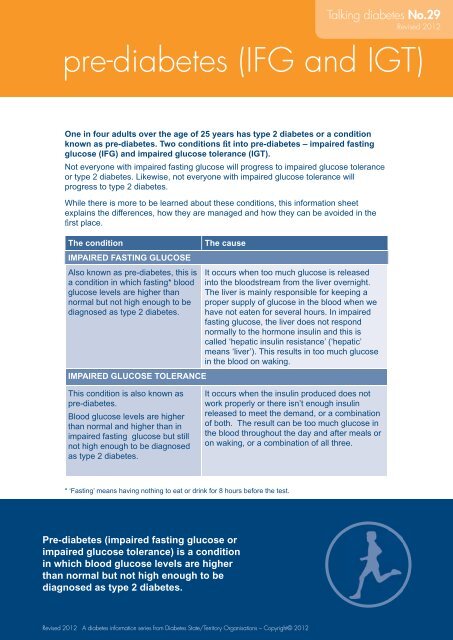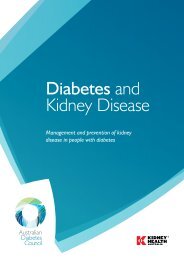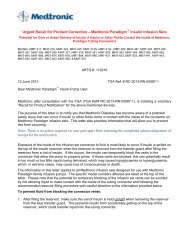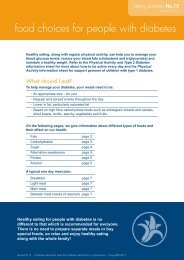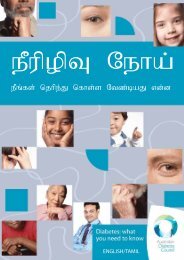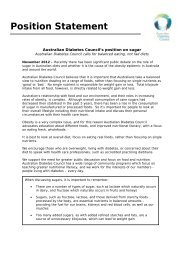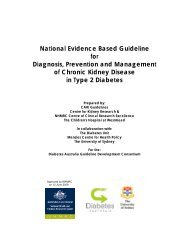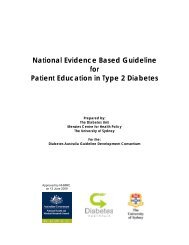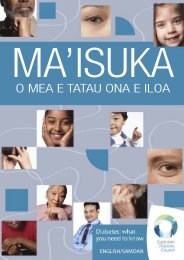pre-diabetes (IFG and IGT) - Australian Diabetes Council
pre-diabetes (IFG and IGT) - Australian Diabetes Council
pre-diabetes (IFG and IGT) - Australian Diabetes Council
You also want an ePaper? Increase the reach of your titles
YUMPU automatically turns print PDFs into web optimized ePapers that Google loves.
Talking <strong>diabetes</strong> No.29<br />
Revised 2012<br />
<strong>pre</strong>-<strong>diabetes</strong> (<strong>IFG</strong> <strong>and</strong> <strong>IGT</strong>)<br />
One in four adults over the age of 25 years has type 2 <strong>diabetes</strong> or a condition<br />
known as <strong>pre</strong>-<strong>diabetes</strong>. Two conditions fit into <strong>pre</strong>-<strong>diabetes</strong> – impaired fasting<br />
glucose (<strong>IFG</strong>) <strong>and</strong> impaired glucose tolerance (<strong>IGT</strong>).<br />
Not everyone with impaired fasting glucose will progress to impaired glucose tolerance<br />
or type 2 <strong>diabetes</strong>. Likewise, not everyone with impaired glucose tolerance will<br />
progress to type 2 <strong>diabetes</strong>.<br />
While there is more to be learned about these conditions, this information sheet<br />
explains the differences, how they are managed <strong>and</strong> how they can be avoided in the<br />
fi rst place.<br />
The condition<br />
IMPAIRED FASTING GLUCOSE<br />
Also known as <strong>pre</strong>-<strong>diabetes</strong>, this is<br />
a condition in which fasting* blood<br />
glucose levels are higher than<br />
normal but not high enough to be<br />
diagnosed as type 2 <strong>diabetes</strong>.<br />
IMPAIRED GLUCOSE TOLERANCE<br />
The cause<br />
It occurs when too much glucose is released<br />
into the bloodstream from the liver overnight.<br />
The liver is mainly responsible for keeping a<br />
proper supply of glucose in the blood when we<br />
have not eaten for several hours. In impaired<br />
fasting glucose, the liver does not respond<br />
normally to the hormone insulin <strong>and</strong> this is<br />
called ‘hepatic insulin resistance’ (‘hepatic’<br />
means ‘liver’). This results in too much glucose<br />
in the blood on waking.<br />
This condition is also known as<br />
<strong>pre</strong>-<strong>diabetes</strong>.<br />
Blood glucose levels are higher<br />
than normal <strong>and</strong> higher than in<br />
impaired fasting glucose but still<br />
not high enough to be diagnosed<br />
as type 2 <strong>diabetes</strong>.<br />
It occurs when the insulin produced does not<br />
work properly or there isn’t enough insulin<br />
released to meet the dem<strong>and</strong>, or a combination<br />
of both. The result can be too much glucose in<br />
the blood throughout the day <strong>and</strong> after meals or<br />
on waking, or a combination of all three.<br />
* ‘Fasting’ means having nothing to eat or drink for 8 hours before the test.<br />
Pre-<strong>diabetes</strong> (impaired fasting glucose or<br />
impaired glucose tolerance) is a condition<br />
in which blood glucose levels are higher<br />
than normal but not high enough to be<br />
diagnosed as type 2 <strong>diabetes</strong>.<br />
Revised 2012 A <strong>diabetes</strong> information series from <strong>Diabetes</strong> State/Territory Organisations – Copyright© 2012
<strong>pre</strong>-<strong>diabetes</strong><br />
So what is the difference<br />
Impaired fasting glucose (<strong>IFG</strong>)<br />
<strong>IFG</strong> is diagnosed when the fasting<br />
blood glucose level is higher than<br />
the normal range, but does not rise<br />
abnormally after having a 75 gram<br />
glucose drink**.<br />
Impaired glucose tolerance (<strong>IGT</strong>)<br />
<strong>IGT</strong> is diagnosed when the blood glucose level<br />
at 2 hours during an Oral Glucose Tolerance<br />
Test **is higher than the normal range but not<br />
high enough to diagnose type 2 <strong>diabetes</strong>.<br />
** Refer ‘How it is tested’ below.<br />
How do you know you have one of these conditions<br />
Any glucose test, fasting or not, that shows blood glucose levels above the normal<br />
range, needs further testing. The doctor may order an Oral Glucose Tolerance Test<br />
to investigate.<br />
How it is tested<br />
An Oral Glucose Tolerance Test is a test used to screen for, <strong>and</strong> diagnose, type 2<br />
<strong>diabetes</strong> or <strong>pre</strong>-<strong>diabetes</strong>. It is a test that is performed at the pathologists <strong>and</strong> requires<br />
specifi c <strong>pre</strong>paration:<br />
• Having at least 150 grams of carbohydrates every day for three days prior to the test.<br />
• Fasting before having a blood sample taken from a vein, usually in the arm, fi rst thing<br />
in the morning.<br />
• Having a sweet drink that contains 75 grams of glucose after the fasting blood sample.<br />
• Resting in a chair during the test until the blood glucose level is tested again two<br />
hours after having had the glucose drink.<br />
How it is diagnosed<br />
The results of this laboratory test show four possible diagnoses:<br />
1. Normal glucose levels<br />
2. Impaired fasting glucose<br />
3. Impaired glucose tolerance<br />
4. Type 2 <strong>diabetes</strong><br />
2<br />
treatment usually involves regular physical activity
Your doctor will review the results before determining the diagnosis using the following<br />
guideline:<br />
Indications Fasting blood glucose Blood glucose two hours<br />
after a 75 gram glucose drink<br />
1. Normal glucose levels 3.6mmol/L Less than 7.8mmol/L<br />
Pre-<strong>diabetes</strong><br />
2. Impaired<br />
fasting<br />
glucose<br />
Equal to or above<br />
6.1mmol/L or more<br />
but less than 7mmol/L<br />
Less than 7.8mmol/L<br />
3. Impaired<br />
glucose<br />
tolerance<br />
4. Type 2 <strong>diabetes</strong> Equal to or above<br />
7mmol/L<br />
Above 7.8mmol/L but less<br />
than 11.1mmol/L<br />
Equal to or above<br />
11.1mmol/L<br />
Who is at risk of developing <strong>pre</strong>-<strong>diabetes</strong><br />
Risk factors for <strong>pre</strong>-<strong>diabetes</strong> are basically the same as those for type 2 <strong>diabetes</strong> which are:<br />
• Being overweight – especially having excess weight around the waist<br />
• Being physically inactive<br />
• Having high triglycerides (bad cholesterol) <strong>and</strong> low HDL-C (good cholesterol) <strong>and</strong>/or<br />
high total cholesterol<br />
• Having high blood <strong>pre</strong>ssure<br />
• Having a family history of type 2 <strong>diabetes</strong> <strong>and</strong>/or heart disease.<br />
Others at risk include:<br />
• Women with Polycystic Ovarian Syndrome (refer to the Polycystic Ovarian Syndrome<br />
<strong>and</strong> <strong>Diabetes</strong> information sheet)<br />
• Women who have had <strong>diabetes</strong> in <strong>pre</strong>gnancy (gestational <strong>diabetes</strong>) or given birth to a<br />
baby weighing 4.5kg or more<br />
• People from Aboriginal <strong>and</strong> Torres Strait Isl<strong>and</strong>er background<br />
• People from certain ethnic backgrounds such as the Pacifi c Isl<strong>and</strong>s, Asia <strong>and</strong> the<br />
Indian sub-continent.<br />
How is <strong>pre</strong>-<strong>diabetes</strong> managed<br />
As people with <strong>pre</strong>-<strong>diabetes</strong> are at risk of developing not only type 2 <strong>diabetes</strong> but<br />
also heart disease, the aim of management is to reduce the risk <strong>and</strong>/or delay the<br />
development of both conditions. Management involves the same lifestyle changes that<br />
are recommended for people who have been diagnosed with type 2 <strong>diabetes</strong>.<br />
3<br />
, healthy eating <strong>and</strong> if necessary, losing weight
<strong>pre</strong>-<strong>diabetes</strong><br />
Can type 2 <strong>diabetes</strong> be avoided<br />
Evidence shows that people with <strong>pre</strong>-<strong>diabetes</strong> are at high risk of progressing to type 2<br />
<strong>diabetes</strong>. However the risk of developing type 2 <strong>diabetes</strong> can be delayed <strong>and</strong> reduced<br />
by up to 60% by adopting healthy lifestyle changes <strong>and</strong> reducing body weight by as<br />
little as 5–10% <strong>and</strong> keeping it off.<br />
Lifestyle changes to avoid type 2 <strong>diabetes</strong><br />
Healthy eating: A healthy eating plan for losing weight <strong>and</strong> reducing the risk of<br />
type 2 <strong>diabetes</strong> should include a reduction in total energy (kilojoule) <strong>and</strong> fat intake,<br />
particularly foods containing saturated fat such as butter, full fat dairy products, fatty<br />
meats, takeaway foods, biscuits, cakes <strong>and</strong> pastries. Instead, choose a wide range of<br />
high fi bre, low glycemic index (GI) carbohydrate foods such as wholegrain breads <strong>and</strong><br />
cereals, legumes <strong>and</strong> fruit. An accredited practising dietitian (APD) can help you work<br />
out a meal plan that’s right for you.<br />
Regular physical activity: Regular physical activity helps your body to use insulin better<br />
<strong>and</strong> to feel fit <strong>and</strong> healthy. Aim to do at least 30 minutes of ‘moderate intensity’ physical<br />
activity (such as brisk walking or swimming) every day OR three 20 minute sessions<br />
of ‘vigorous intensity’ exercise per week (such as jogging, aerobics class, strenuous<br />
gardening). Try to include some resistance training twice a week to improve the way your<br />
muscles work (such as body weight exercises or lifting weights such as cans of food).<br />
Starting a regular activity program – <strong>and</strong> sticking to it – can often be made a lot easier<br />
by joining up with a group or motivated friend to encourage you to keep going.<br />
• Before starting any new type of physical activity, always talk to your doctor.<br />
• To find a local accredited practising dietitian (APD) contact your state or<br />
territory <strong>diabetes</strong> organisation on 1300 136 588, the Dietitians Association of<br />
Australia on 1800 812 942 or their website www.daa.asn.au.<br />
Would you like to join Australia’s leading <strong>diabetes</strong> organisation<br />
> Dietary services > Free magazines > Children’s services<br />
> Educational literature > Product discounts > Support groups<br />
For more information phone 1300 136 588 or visit your State/Territory Organisation’s website:<br />
ACT www.<strong>diabetes</strong>-act.com.au NSW www.australian<strong>diabetes</strong>council.com<br />
NT www.healthylivingnt.org.au QLD www.<strong>diabetes</strong>queensl<strong>and</strong>.org.au<br />
SA www.<strong>diabetes</strong>sa.com.au TAS www.<strong>diabetes</strong>tas.com.au<br />
VIC www.<strong>diabetes</strong>vic.org.au WA www.<strong>diabetes</strong>wa.com.au<br />
The design, content <strong>and</strong> production of this <strong>diabetes</strong> information sheet have been undertaken by:<br />
> ACT <strong>Diabetes</strong> ACT > NSW <strong>Australian</strong> <strong>Diabetes</strong> <strong>Council</strong><br />
> NT Healthy Living NT > QLD <strong>Diabetes</strong> Australia – Queensl<strong>and</strong><br />
> SA <strong>Diabetes</strong> SA > TAS <strong>Diabetes</strong> Tasmania<br />
> VIC <strong>Diabetes</strong> Australia – Vic > WA <strong>Diabetes</strong> WA<br />
The original medical <strong>and</strong> educational content of this information sheet has been reviewed by<br />
the Health Care <strong>and</strong> Education Committee of <strong>Diabetes</strong> Australia Ltd. Photocopying this publication<br />
in its original form is permitted for educational purposes only. Reproduction in any other form<br />
by third parties is prohibited. For any matters relating to this information sheet, please contact<br />
National Publications at dapubs@tpg.com.au or phone 02 9527 1951.<br />
Health professionals: For bulk copies of this resource, contact your <strong>Diabetes</strong> State/Territory Organisation as listed.<br />
Revised 2012 A <strong>diabetes</strong> information series from <strong>Diabetes</strong> State/Territory Organisations – Copyright© 2012


